Interviewing active listeners and tracking music services could be good (additional) ways to find out which songs your audience likes to hear on the radio.
Following part 1 of our talk with music radio programmer Steve Warren, we now talk about more things he’s learned during a long career. He likes to think beyond conventional radio research methods, and has a strong opinion about one in particular. “Callout research has always been bullshit, but as a program director, you come to rely on those figures.”
“Those guys were monsters”
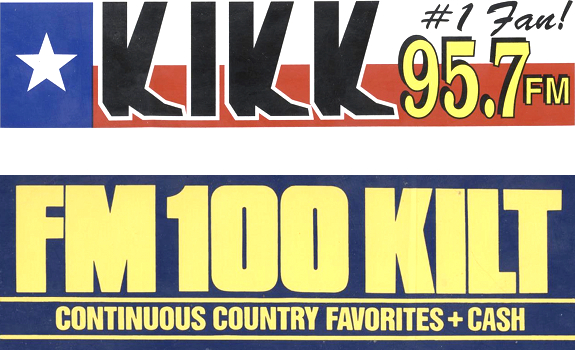
KILT and KIKK had very strong positions when KKBQ became Houston’s 3rd Country format (images: KILT, KIKK)
Go for major markets
“The Beatles hit America in January 1964, when I was a 16-year-old kid. That summer, I went on the air as a Top 40 DJ. I had been listening to radio since I was much younger, and heard the beginnings of Top 40. I was hired by another station and became a program director when I was 18. I was completely unqualified, but I had the title!” It was the beginning of his career in 12 different markets (“you’ve had to move to move up”) as a program director or music director, often combined with the afternoon, evening or morning on-air shift. “I tried to avoid mornings, because especially before I got married, I liked to party a lot…” He made a career move in 1980, when he got hired by a CHR in Milwaukee, and also got to program its Country sister station. A year later, he launched his consulting business, focused on that format. “I started getting more business from Country stations in small markets than from Top 40.” It was a time when Country evolved into a more up-tempo format, also because of the movie Urban Cowboy with a soundtrack full of hit singles: “When I started applying Top 40 techniques to Country, it was quite successful.”
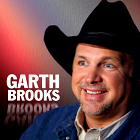 Create an up-tempo mix
Create an up-tempo mix
Which CHR techniques did you apply to Country, and why did they work?
“Until then, Country had been a very ballad-driven, power current and Oldies-based format, like a Lite AC. They typically played no more than 5 new songs an hour, and you could hear 3; 4; 5 slow ones in a row.” Warren decided to play 60% currents, and don’t play 2 slow songs back-to-back. “That became known as the Hot Country format.”
Consider great album tracks
It was difficult to sell the new format to program directors during the mid 1980s, as it was a “radical” change compared to how Country used to be. Things took off once Garth Brooks hit the charts in ’89. A milestone was signing KKBQ in Houston in ‘92, one of the biggest Country markets in the States (along with Dallas). Even though most Country records were sold in New York and Los Angeles, because of the size of these markets, The Lone Star State was a real trendsetter. “The word was that if a Country record didn’t make it in Texas, it couldn’t make it anywhere. KKBQ became the most-copied Country station. We were running an up-tempo, current-intensive format, and started to play album cuts in heavy rotation. KKBQ won Major-Market Station of the Year and Country Station of the Year awards, and became the second-highest billing Country station in America in 1996.” Good for a newcomer in a market with already 2 established Country stations, KILT and KIKK: “Those guys were monsters, and we were the new kid on the block.”
“This has the potential
to screw up radio even more”

There are questions about promotion deals between radio and the music industry (images: SixStringMadness, Flickr)
Invest while keeping ROI
Steve Warren moved to Dallas in 2000 to program KPLX (’99.5 The Wolf’) in a time when consolidation came as result of the notorious Telecommunications Act of 1996. When he first got into the radio business, companies could own a maximum of 1 AM and 1 FM station in a total of 7 markets. Then it was allowed to own 2 stations in 14, and later in even 21 markets. But it wasn’t until the Telecom Act that ownership limits were completely lifted and Wall Street got involved. “Radio was a license to print money. If you owned a station, it was hard to go broke. After your transmitter, building and electricity, what were your expenses? People. Plenty of stations were profiting 50 cents a dollar, while covering all of their expenses and staff.” He says that those who were “doing it right” by investing in good news departments and station promotions could still have a healthy profit margin of 30%. The problem was that after ‘Telecom’, many “borrowed tons of money, and paid way too much for stations” in their hope to make a quick buck.
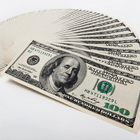 Pay the right price
Pay the right price
During the 1990s, entrepreneurs would buy a radio station for 8-9 times its annual cash flow. “If you were doing a million dollars a year, you could sell the station for 8-9 million dollars.” Once the Telecom Act was signed, stations were suddenly being sold for as much as 20-30 times their annual cash flow. “It went through the freaking roof! It was all somebody else’s money, and the interest rates were very high. So what can you get rid off? People.”
[audio:http://www.radioiloveit.com/wp-content/uploads/steve-warren-music-scheduling-radio-consultant-interview-06.mp3|titles=Steve Warren about Telecom Act consequences]
Stay away from payola
“What you hear in one market, is what you hear in another market. I can travel from Austin to Houston, and hear the same station with different ads.” In a desparate try to pay off debt (or at least pay interest rates), radio operators now make deals with the record industry. Warren questions whether broadcasters should have marketing agreements with labels: “It’s always been a dicey business anyway”, he says in reference to payola. “This has the potential to screw up radio even more. When you and I were on air, we would pick songs based on what we and our listeners liked; make choices based on gut feeling, and knowledge of the market and audience.” Another big issue is the amount of commercials on American ‘music’ stations these days. He’s recently heard a station play 12 commercials in a row, spin 1 song, and run 8 more spots before finally starting a music sweep (instead of programming commercial breaks strategically).
“We’re also playing
all these other songs by Brooks & Dunn”
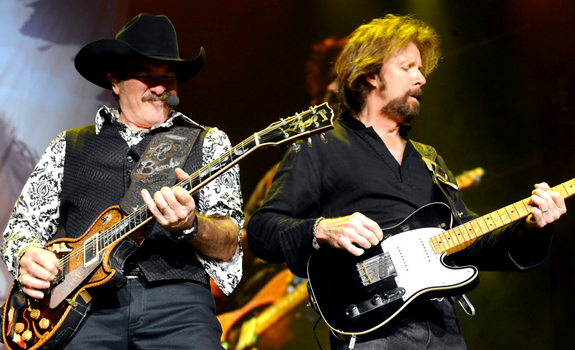
Artist separation rules may interfere with intended song rotations for format core artists (image: Stuart Davis)
Open music sweeps energetically
So it’s going to be an interesting time over the next couple of years. Speaking of time, and going back to music scheduling, what do you think are good ways to build a format clock?
“The original clock idea was coming out of the news with an up-tempo, very familiar song. You would also follow contest promos and commercial breaks with a power song. For a Top 40 station, it would be up-tempo.” He explains that format image and music flow are often based on tempo, like how many slows are allowed to play back to back (if at all). “If you came come out of the news and 4-5 stopsets an hour with an up-tempo song, everything else fell into place; it was clear where your ballads where going to go.” It was the same for music categories, for example: playing a power song after a news bulletin or a commercial break in CHR. “Around them were new songs, and oldies – provided that these were hit records; familiar to the majority of your listeners. The only unfamiliar songs were your new adds. It all worked if your music selection was right on, with a few basic rules to determine the hourly makeup of your station.”
 Let songs rotate naturally
Let songs rotate naturally
Steve Warren feels like record rotations are actually secondary to music flow. When he consulted KKBQ Houston from 1992, they played many songs by popular Country duo Brooks & Dunn. Their biggest hit was Neon Moon, a ballad which by that time was in the Power Gold category. The station would put power golds on a rotation of 8 times a week, in other words: a little more than once a day.
Create flow through tempo
The challenge was that KKBQ also played several current B & D songs: “We had an artist separation on Brooks & Dunn, and decided to have a tempo rule as an up-tempo station – while Neon Moon is a slow song. One day, I was at the station when program director Dene Hallam was reviewing song histories, and hit the roof. He called in the music director and screamed at him: ‘we have paid 15.000 dollars for this music test, so we know that Neon Moon is the second-most powerful oldie we’ve got – and you’ve only played it 4 times this week!’ After the poor guy had left the room, I said: Jesus, Dene, it’s not that important. We’ve played Neon Moon 850 times since it was released. KILT and KIKK have played it nearly as much. It’s the most thoroughly played song. No, it hasn’t burned out, but we’re also playing all these other songs by Brooks & Dunn.” He adds that Hallam was the only PD to win the Radio & Records Program Director of the Year award for both CHR and Country, and that he was looking at music policies from the perspective of his successful stints in New York and San Diego.
“The dollar spent for the record
was the single most important vote”

Before everyone started downloading, record sales were still a good indicator for song popularity (image: Wikipedia)
Support a great song
In Warren’s opinion, today’s generation of radio programmers is focusing too much on the numbers, while there’s a lack of reliable radio research data. “I was the first to write an anti-callout research article in Radio & Records in the late 70s. Callout research is ridiculous.” He was consulting 99.5 The Wolf in Dallas in the 1990s, when young LeAnn Rimes came out with Blue – originally written for Patsy Cline, who never had a chance to record it, so the song was forgotten for decades. “In the midst of the Hot Country movement with Garth Brooks, Clint Black, Shania Twain and Brooks & Dunn, out comes this song that had yodeling in it. It was a monster hit! I was the first to play it in a larger market, on a station in Amarillo. The program director called me the next day. ‘Steve, my God, you won’t believe it. I’ve played it, and all listeners on the request line are asking for Blue; it’s the only thing they want to hear!’ I said: wow – put it in Power Current!” The same happened in other markets, and it quickly became a top-selling Country single. Still, one PD initially pulled the song right after it was tested, because the callout was allegedly ‘bad’:
[audio:http://www.radioiloveit.com/wp-content/uploads/steve-warren-music-scheduling-radio-consultant-interview-07.mp3|titles=Steve Warren about callout research problems]
 Check (callout) interview practices
Check (callout) interview practices
He feels like interviewer cheating is a major problem in callout research, even more than small sample rates, crappy telephone lines, and socially accepted answers. Researchers should rather pay interviewers for their time, and not based on how many surveys they complete. This precaution may eliminate any temptation for interviewers to fake some results, because there is no time pressure to reach interview quotas.
Talk to P1 listeners
“For a sample of 100 people, you may have 4 interviewers who are supposed to do 25 interviews each. If 5 out of those 100 interviews are faked, any statistician will tell you that this is now a completely unreliable sample.” Steve Warren refused to do any callout research for KKBQ in Houston. Instead, they hired a staff to answer the incoming telephone lines. They would write down every request, and ask questions such as: What else do you like? Is there anything we play that you don’t like? Who’s listening along with you? What’s their favorite record? He realizes that it was one-sided, as it was based on incoming calls only – and a lot of listeners simply never call a radio station. “But they were active listeners, as we used to name them in early research terms”. Back then, sales was an indicator as well. “The dollar spent for the record was the most important vote in favor of playing a record, providing it was spent by people you thought are your listeners. As a Country station, we watched the Country charts.”
“You cannot really
watch record sales anymore”
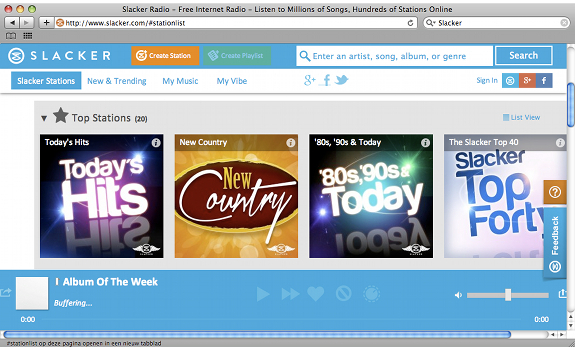
People’s average behavior while listening music online might give a good indication of song popularity (image: Slacker)
Recruit a representative sample
When Dene Hallam programmed Country KSAN in San Francisco, the station used a well-known company for music research. Hallam, who had major-market programming experience, noticed that callout results for some songs varied a lot from week to week. He called the research company, and they explained that it had become really difficult to recruit enough people who listen to the format’s main music genre for at least 1 hour a day. As it was so expensive to find enough of these people, management had agreed that someone who listened to just 1 hour of Country a week would now qualify as well. “It could be an 18-year-old girl who’s daddy liked Country, which she heard 1 hour a week – on Saturday morning, while helping her dad wash the car! Callout research has always been bullshit, but as a program director, you come to rely on those figures. In our business it’s impossible to really know if we’re doing it right. We don’t have a product that people buy in a store. So when the ratings go down, you can go into the general manager’s office and say: look, we were playing the absolute best music, so it isn’t my fault if the ratings go away.”
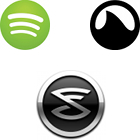 Follow online streaming services
Follow online streaming services
So what could be a better way to test current music, in your opinion?
“We used to be able to watch requests and sales. With the coming of Spotify and Grooveshark, you cannot really watch record sales anymore.” Warren is now beginning to look at services like Slacker, which includes genre-based charts based on the number of song starts, song skips, social shares, thumbs up, and thumbs down on a song.
Resonate with your listeners
Can you also see the demographics of people who like a certain track?
“They haven’t got it right now, but Slacker has an overall Top 40 chart, and separate charts for Pop, Rock, Electronic, Dance, Country, Hip Hop and Alternative. Two big Country stars, Miranda Lambert and Carrie Underwood, have a duet called Somethin’ Bad. It’s still trending upwards on radio airplay charts, but on Slacker it’s dropping off. It had a 10-point drop last week, and dropped another 10 this week. Most Country stations have that thing in Power Currents right now, while it might be time to get rid of that record.” He mentions YouTube as another good place to see what people seem to like. “Try to be in touch with your audience, and figure your way through. If you’re a music director, you have to like the format that you’re in. I could program a Top 40 station again today, but I couldn’t pick music for it. I could handle the formatics, deejays, promotion and positioning, but I would have to hire somebody that is really into that music.”
“The most successful disc jockeys
always talked about the music”
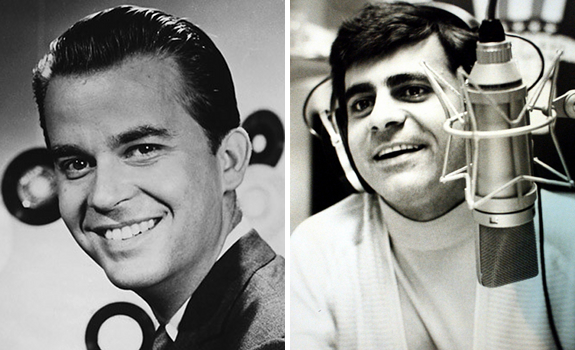
The late Dick Clark and Casey Kasem were the Elvis Duran and Ryan Seacrest of their time (photos: Viertap, private)
Rotate TOTH power categories
Getting back to clock technology again, do you believe in certain sequences? Like ‘power current, new song, power recurrent, secondary current’, and so on?
“The one thing that I would say is that unfamiliar records – your new adds – need to have a familiar record on either side of them. Back when radio actually did news, which was usually at the top of the hour, I would spend a week coming out of the news with a power gold. The next week, I would change it and come out of the news with a power current, and the week after with a power recurrent, just to mix it up.” Steve Warren also used to rotate 3 different basic format clocks throughout the day, opening each with one of those 3 power categories, but says there are many ways to do it. “Phil Hall, who put KRTH on the map in LA, likes to have a ‘rotating chart’, a sequence of 15 songs. In the hour, you may only play 14 songs, so every hour opens differently. He’s a super successful guy, so there are many ways to do it. If Miles Davis hit the stage and played music from Bitches Brew, he never played it the same every night. But you could have gone in, sit down, and if you knew him and the album, you knew what he was playing!”
 See the audience perspective
See the audience perspective
We never know if a jock plays all songs on a prescheduled log, so how does that affect our music rotation and song history?
“Big deal. It’s only important to us. It’s like Dene Hallam, yelling at the music director because Neon Moon didn’t get a few more plays. It didn’t cost the station one listener.” He argues that PDs should keep in mind on how people actually listen to the radio.
[audio:http://www.radioiloveit.com/wp-content/uploads/steve-warren-music-scheduling-radio-consultant-interview-08.mp3|titles=Steve Warren about music policy exaggeration]
Include (more) music content
Talking about keeping things interesting – how can we, as radio programmers, keep on-air shifts interesting for jocks that are playing the same songs all the time?
“I used to tell my disc jockeys: we’re not normal people. You get to be on the air every day and do this; you don’t have to go out and dig ditches. You sit in an air-conditioned room, you play music, and girls call you all the time. It’s a hell of a job we’ve got here!” Warren thinks that on-air talents are there to do something interesting in between the music, and speak about it. “The most successful disc jockeys of all time, Dick Clark and Casey Kasem, always talked about the music. They did some dedications – featuring people who like the music, and their relation to the music – but they never spoke about politics or anything else. So, talk about the music, and don’t knock anything. I never wanted smartasses on the radio.” When being asked what he thinks of exceptional talent that fits the format, such as Howard Stern would do on an Active Rock station, he makes a distinction. “Howard Stern is not a disc jockey, he’s a radio personality.”
‘Use every opportunity to
talk with your audience’

Observing and interviewing your potential listeners may help you to understand your target demo (photo: Flickr)
Speak with listeners continuously
What is your single most important advice for any music director, in any format, in any market?
(Silence) “Listen to your listeners. Constantly observe what happens with your target audience. Which movies do they see; which TV shows do they watch? Which concerts do they attend, and do they sell out? Who are your people into sports-wise? If they go to bars before and after a game, what kind of music do they play in the pub? Could you play music that goes along with their good feelings and fits your station? If you ride the bus and see somebody who looks like your listener who has earplugs in, you might not want to disturb – but when they take their plugs out, ask them a question. ‘Hi, do you mind me asking: what were you listening to? So what kind of music do you like? Do you like this artist?’ If it’s an artist you’re playing, ask: ‘Who else do you like?’ His advice is to use every opportunity to talk with (people who look like) your audience, and to answer the telephone lines a lot. They did this at KKBQ in Houston:
[audio:http://www.radioiloveit.com/wp-content/uploads/steve-warren-music-scheduling-radio-consultant-interview-09.mp3|titles=Steve Warren about active listener interviews]





Nowadays, it is trivial to develop a web application to do all that stuff. A proprietary, Windows-only application is no longer necessary. A modern development team could knock out a reasonable implementation in a few weeks.